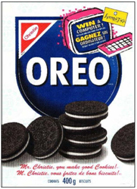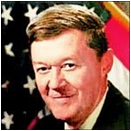A friend and colleague taught me the best way to capture a person's interest is by telling stories. The following is a small collection of ones that relate directly to our pedigree.
Oreo™ Cookie (Out-of-the-box Success)
MediaLynx was the operating arm of the Stentor Group of telephone companies, effectively headed by Bell Canada. They were the developer of Sympatico™, ultimately the largest ISP in Canada.
Wasserman was tasked with creating an advertising revenue stream based on a commitment from the corporation they would have 100,000 families signed on by the end of the first year of operation. Sadly, at the end of six months they had less that ten thousand sign-ups. He took this as an opportunity to reach out to his network and partnered with Christie-Nabisco to create an instant-win promotion using Oreo cookies. This was extremely successful resulting in 140,000 sign-ups by the end of the year and over $25 million in revenue. The cost to MediaLynx was a mere $300.00 in out-of-pocket expenses to cover the cost of colour separations for the specialized packaging (an 80,000X ROI).

Dr. D. Bruce Merrifield, PhD (Mentorship)
I met Bruce at the 30th Anniversary celebration of the Binational Industrial Research and Development (BIRD) Foundation at the National Academy of Science building in DC in 2007. He was one of the honorees that morning and we wound up sitting next to each other at lunch. We spoke about entrepreneurship and his thesis that if you export entrepreneurship, democracy follows. That evening there was a formal reception at Constitution Hall and the funny thing was he sought me out. At the end of the evening he suggested we meet again at the Cosmos Club the following week.
Little did I know not only would he become my mentor, but this chance meeting would lead to a decade long friendship that only ended when he died.
Bruce's accomplishments were many. He was the Assistant Secretary of the US Department of Commerce for Technology and the Undersecretary for Economic Affairs, 1981-89. During that time, in addition to being the "behind the scenes guy" for Israel becoming "Start-Up Nation," he also drafted two key pieces of legislation that ensured US entrepreneurial success; the Small Business Innovation Research grant (SBIR) and the Limited Liability Company (LLC). The funding attached to the former was strongly tied to commercializing the undertaking, while the latter's owner protection and flow-through share provisions off-loaded any taxes from the company to the shareholders, effectively sheltering the assets of the small enterprise.
When you look back at his life, and especially where he replicated the model he refined for the BIRD Foundation, it is no wonder entrepreneurs in countries like the Israel, the US, Ireland, India, Finland and Chile have succeeded while others in Canada, the UK and elsewhere still struggle.
However, the most important thing I learned from Bruce was that to achieve commercial success it is imperative to include Business Development expertise at the same time an entrepreneur is engaging Legal, IP, and Accounting.

The Health Ecosphere (Intrapreneurship)
What happens when need, opportunity, experience, contacts, and good people get together to fix something that hasn't gone beyond the initiation phase after numerous previous attempts?
At the time, for health innovators, there were two existing programs; 1) the Health Technology Exchange (HTX) and 2) MaRS Excite!
The former was targeted towards big projects and was well financed while the latter was for somewhat smaller projects and supported by the backing of the MaRS Discovery District in Toronto. However, neither went to the grass roots level to advance the innovations that were either coming out of or targeted towards the type of challenges community hospitals face.
ventureLAB was itself an amalgamation of the Innovation Synergy Centre of Markham (ISCM) and York Biotech. Although in 2011 the IT sector was dominant, the organization had to still support health-related innovations. To address this, the MedEdge Summit was started and immediately highlighted the disconnect between what was needed by the community hospitals and the health innovations from the local pioneers.
Recognizing the impasse, Wasserman wrote Jeremy Laurin, the CEO of ventureLAB an email stating that since health in Canada is "government," from his past experience along with a current client as an example, he felt there were ways to address this. Laurin wrote back "put a team together and see where this goes."
The rest is history.
However, how the Ecosphere differed was much more than addressing the community hospitals' needs. Likewise, the intake was well beyond a glorified "Dragon's Den." For the first time the program included direct input from ALL the participants necessary to advance success. That is, corporate legal advisors, plus IP legal, accounting, banking, finance, angel investors, non-dilutive funds, health-tech industry associations, senior management from the local hospitals, and experienced mentors were all directly involved in selecting the innovators that would be supported while the innovators had the opportunity to select which areas of support they felt they needed. All this was done with a rigorous pre-selection rubric followed by "speed dating" session between the two parties, and then followed by an equally rigorous post-selection process. Moreover, those who were not chosen were given the opportunity of a detailed de-briefing.
Not surprisingly, after the first intake session Wasserman was asked to expand the Ecosphere to include additional facilities in such locales as Mississauga (Trillium Health), Brampton (Wm. Osler), and even CHEO in Ottawa.